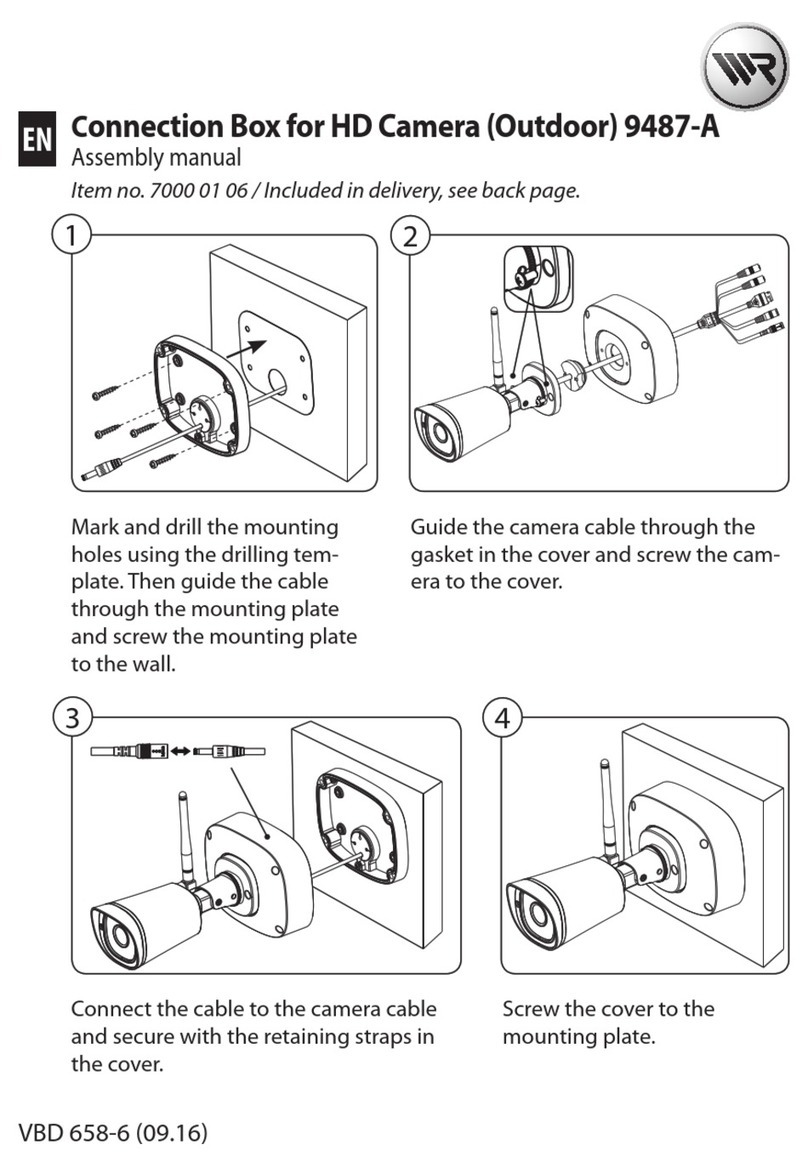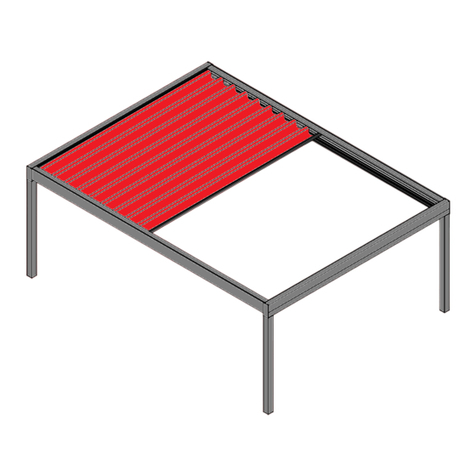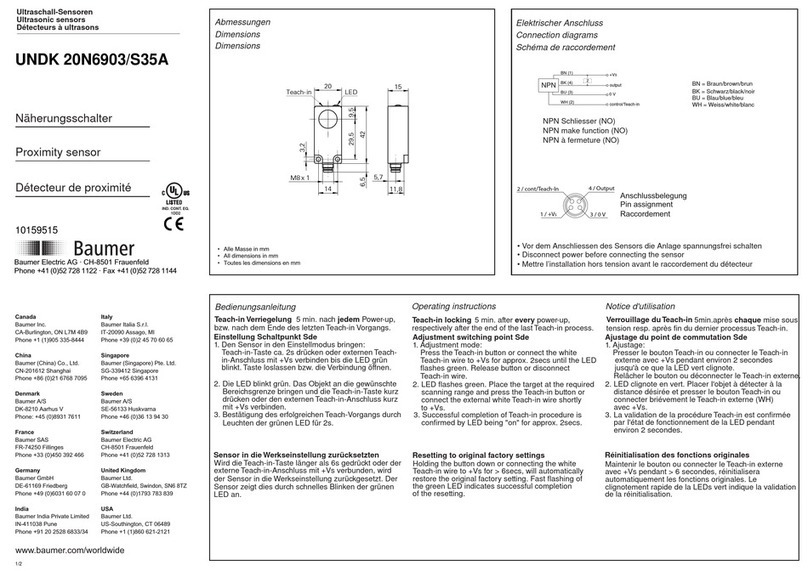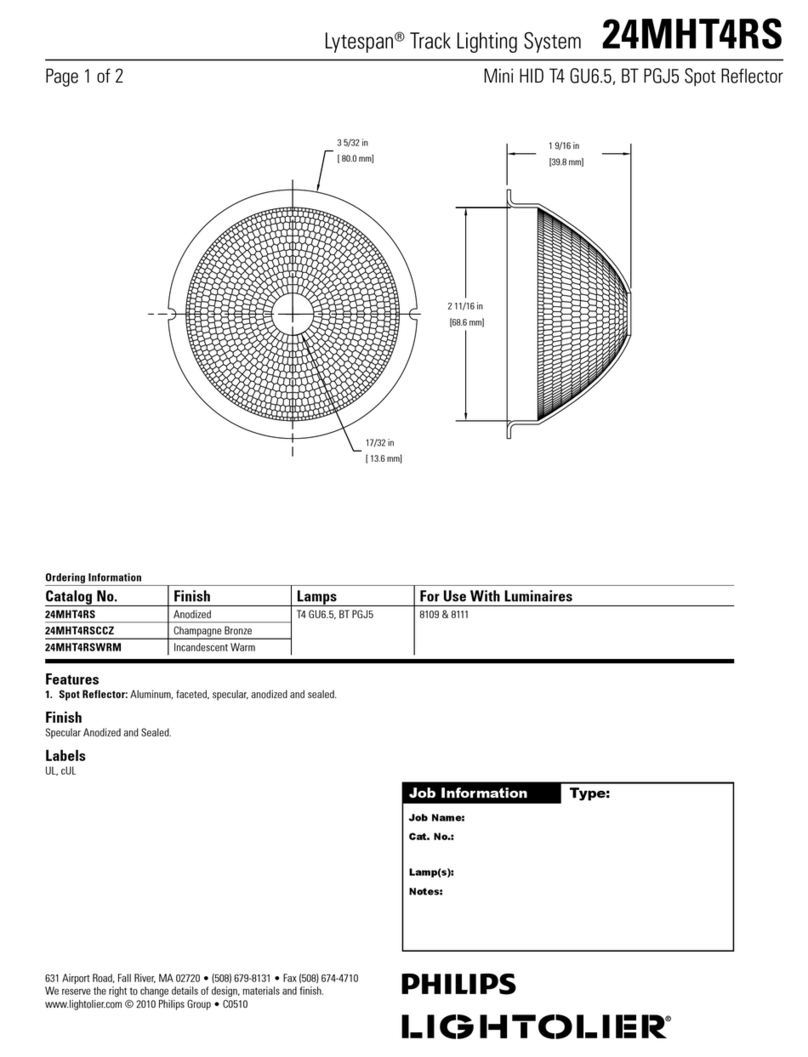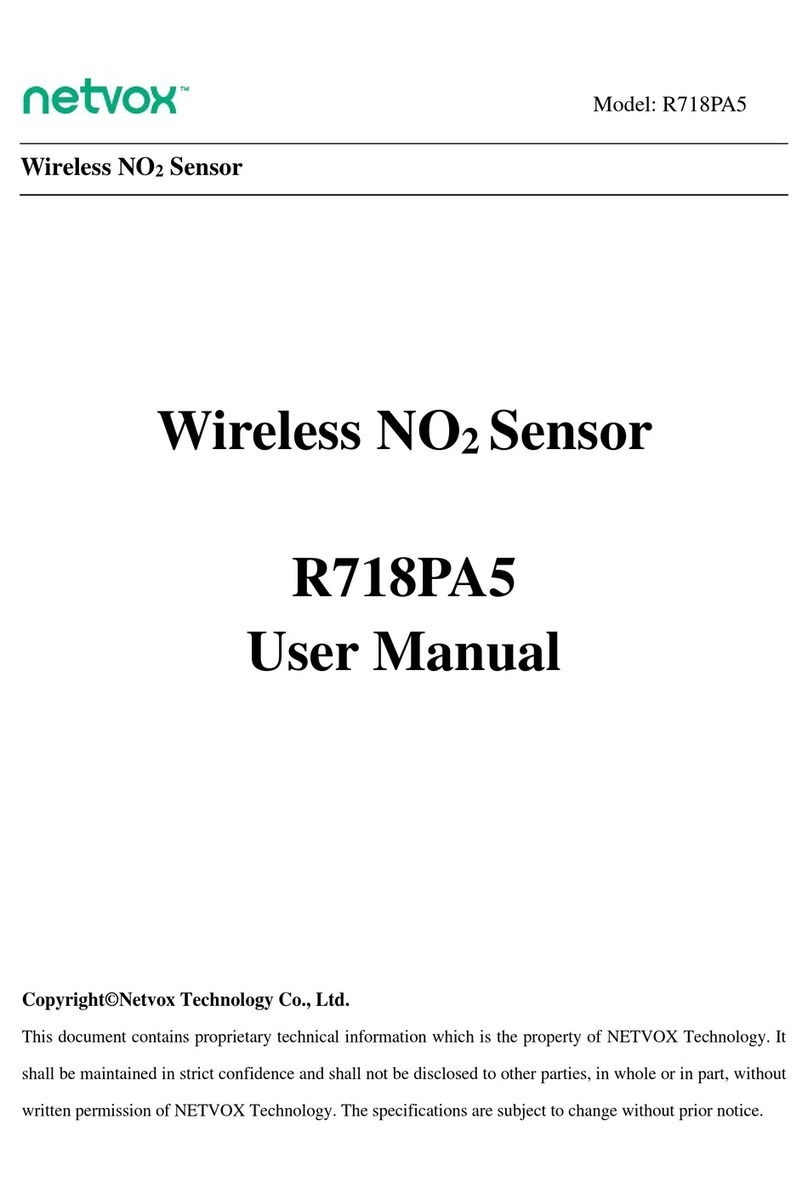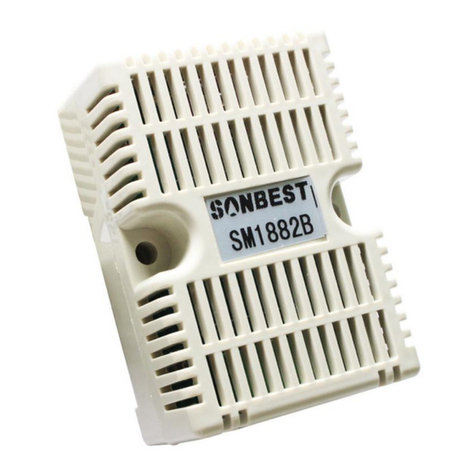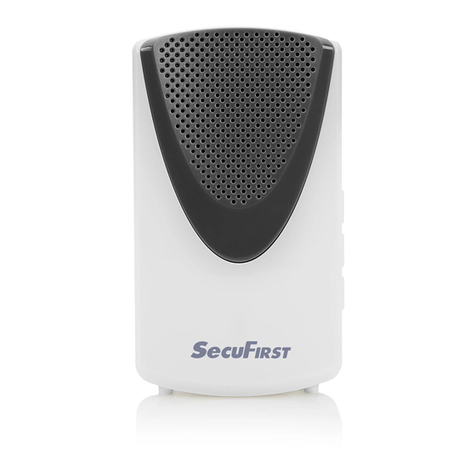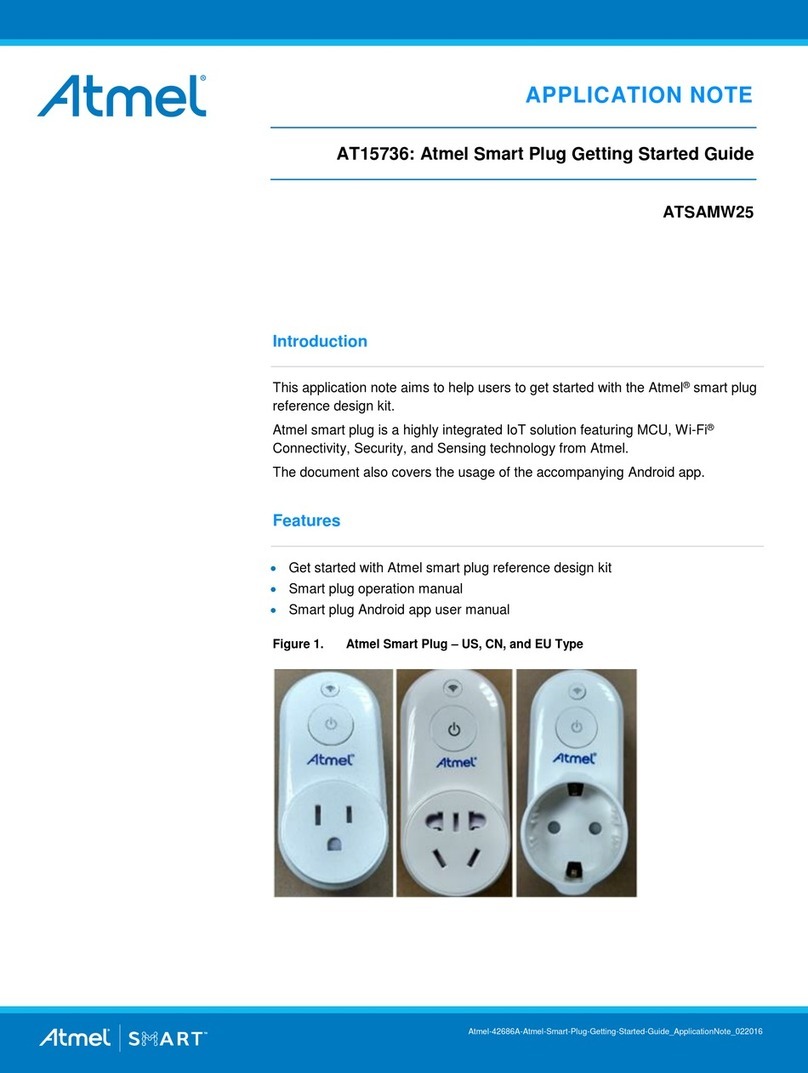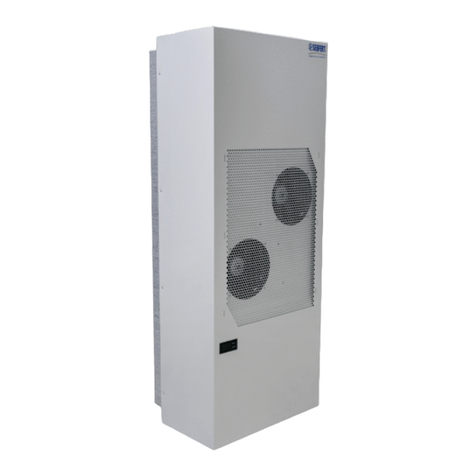Audiolab LIVE SNAKE 16.8 User manual

P. 1
- AUDIOLAB Live Snake 16.8
LIVE SNAKE 16.8
Dante® audio interface
USER MANUAL

P. 2
AUDIOLAB Live Snake 16.8 -
LIVE SNAKE 16.8
Dante® audio interface – 16x8 inputs/outputs
Live Snake 16.8 is a Dante® audio interface with
8 inputs and 8 outputs which allows the signal to
be transported in a simple Cat5 cable. Thanks to
this, the audio can travel up to 100 meters with-
out suering distortions or losses, in addition to
the great exibility that the protocol provides.
Live Snake 16.8 sports signal, clip and phantom
power indicators per channel and transmits with
ultra low latency, allowing the user to monitor and
route the signal at any time from a computer.
Specications
Performance
• Transmitting digital signal in real time
• Point to point and multipoint transmission
• 16 analog inputs
• 8 analog outputs
• Analog gain control
• Led indicators for signal, clip and 48V phan-
tom power in each channel
• 48V phantom power dip switch assignment
• Various connection available using Ethernet
Cat5(e) cable
• 8/In-8/Out Dante® Module
Specications
• Electronically balanced microphone inputs
• Frequency Response: 20Hz~20kHz @ 0dBu
(±1.5dB)
• THD&N: <0.01% @ 0dBu (1kHz)
• Gain: 0dBu~50dBu
• Signal-to-Noise ratio: 107dB
• Maximum Input Level: +20dBu
• Phantom Power: (±3V) +48VDC
• Maximum Outputs Level: +20dBu
• Microphone input impedance: 6.8kOhms
• Output impedance: 240kOhms
• Operating free-air temperature range:
0~40ºC
• Storage temperature range: -20ºC~45ºC
System Crosstalk
• Input to Output: -88dBu @ +0dBu (1kHz)
• Adjacent Channels: -85dBu @ +0dBu (1kHz)
Connectors
• 2 RJ-45 Ethernet connectors
• 16 XLR-3 female connectors
• 8 XLR-3 male connectors
Physical
• Weight: 4.7 Kg. / 10.3 Lbs.
• Dimensions: 284x483x132 mm. / 11x19x5,2 in.
1. OVERVIEW
English version

P. 3
- AUDIOLAB Live Snake 16.8
English version
2. SAFETY RELATED SYMBOLS
To reduce the risk of electric shock please do
not remove the cover or the back panel of this
equipment.
There are no parts needed by user inside the
equipment. For service, please contact quali-
ed service centers.
This symbol, wherever used, alerts you
to the presence of un-insulated and
dangerous voltages within the product
enclosure. These are voltages that may be suf-
ecient to constitute the risk of electric shock or
death.
This symbol, wherever used, alerts you
to important operating and mainte-
nance instructions.
Protective Ground Terminal.
AC mains (Alternating Current)
Hazardous Live Terminal
ON: Denotes the product is turned on.
OFF: Denotes the product is turned o.
Caution
Describes precautions that should be observed to
prevent damage to the product.
1. Read this Manual carefully before operation.
2. Keep this Manual.
3. Be aware of all wamings reported with this
symbol.
4. Keep this Equipment away from water and
moisture.
5. Clean it only whith dry doth. Do not use sol-
vent or other chemicals.
6. Do not damp or cover any cooling opening.
Install the equipment only in accordance
with the Manufacturer's instructions.
7. Power Cords are designed for your safety.
Do not remove Ground connections! If the
plug does not t your AC outlet, seek advice
from a qualied electrician. Protect the pow-
er cord and plug from any physical stress
to avoid risk of electric shock. Do not place
heavy objects on the power. This could cause
electric shock or re.
8. Unplug this equipment when unused for
long periods of time or during a storm.
9. Refer all service to qualied service person-
nel only. Do not perform any servicing other
than those instructions contained whithin
the User's Manual.
10. To prevent re and damage to the product,
use only the recommended fuse type as
indicated in this manual. Do not short-circuit
the fuse holder.
Warning
To reduce the risk of electric shock and re,
do not expose this equipment to moisture or
rain.
Dispose of this product should not be placed
in municipal waste and should be separate
collection.
Before replacing the fuse, make sure that the
RISK OF ELECTRIC SHOCK
DO NOT OPEN.
CAUTION!

P. 4
AUDIOLAB Live Snake 16.8 -
English version
product is OFF and disconnected from the AC
outlet.
11. Move this Equipment only with a cart,
stand, tripod, or bracket,
specied by the manufac-
turer, or sold with the Equip-
ment. When a cart is used, use
caution when mobing the cart/
equipment combination to
avoid possible injury from tip-over.
12. Permanent hearing loss may be caused by
exposure to extremely high noise levels. The
US Government's Occupational Safety and
Health Administration (OSHA) has specied
the permissible exposure to noise level.
These are shown in the following chart:
According to OSHA, an exposure to high SPL in
excess of these limits may result in the loss of heat.
To avoid the potential damage of heat, it is recom-
mended that Personnel exposed to equipment
capable of generating high SPL use hearing protec-
tion while such equipment is under operation.
The apparatus shall be connected to a mains sock-
et outlet with a protective earthing connection.
The mains plug or an appliance coupler is used as
the disconnect device, the disconnect device shall
remain readily operable.
Hours x day SPL Example
890 Small gig
692 Train
495 Subway train
397 High level desktop monitors
2100 Classic music concert
1.5 102
1105
0.5 110
0.25 or less 115 Rock Concert

P. 5
- AUDIOLAB Live Snake 16.8
English version
3. CONTROLS
9. Signal LED This LED indicates status of the
relative channel’s input signal. It will be light
green slightly when the signal is >-10dB.
10. Analog output channel XLR jack for output-
ting analog signal.
Front panel
1. Power switch Push the top part of the switch
to turn on your unit. Push the bottom part of
the switch to turn it o.
2. USB upgrade port This port use to upgrade
rmware.
3. Power LED This LED indicates if the unit is
power on by lighting on.
4. Phantom power switch Turn the switch up to
supply the 48V phantom power to the corre-
sponding input channel.
5. Analog input channel XLR jack for inputting
analog signal. The PUSH table can be used to
release a connecting cable.
6. Input gain control Adjust the input gain from
0dB to +40dB.
7. Phantom power LED This LED indicates if the
48V phantom power is supplied to the relative
channel by lighting on.
8. Signal clip LED This LED will be lighted red af-
ter the signal is >+10dB to indicate the relative
channel is experiencing a signal overload.

P. 6
AUDIOLAB Live Snake 16.8 -
English version
Rear Panel
11. AC INPUT Used for AC input.
12. DANTE port There are two DANTE ports
labeled "primary" and "secondary". Only the
primary Ethernet port needs to be connected,
but if both ports are connected they become
a redundant failsafe. That is, if the primary
port loses communication, the secondary port
quickly takes over. Careful network design and
topology which takes advantage of this fea-
ture can provide extremely high reliability in
critical applications. Each Ethernet port equips
with two LEDs. The yellow LED of the Second-
ary Ethernet port will light to show you that
the Ethernet port is able to use after power
on the DSS. The green LED of the Ethernet
port which connected will ash if there is data
transmitting.

P. 7
- AUDIOLAB Live Snake 16.8
English version
4. APPLICATION
About DANTE
This product uses the Dante digital audio network
protocol to send and receive audio signals. The
default conguration network audio protocol is 16
in 8 out DANTE network audio. (The other:the de-
fault conguration network audio protocol is 8 in
16 out DANTE network audio.) Dante is a protocol
developed by Audinate that is designed to deliver
multichannel audio signals at various sampling
and bit rates, as well as device control signals over
a Gigabit Ethernet network. For information about
Dante, please visit the Audinate website. http://
www.audinate.com/
Firmware Upgrade
The module rmware is upgradable over the net-
work. Firmware upgrades are performed by up-
loading the upgrade le via either the device web
interface or via the provided rmware upgrade
tool. Software and rmware version information
can be obtained via the device web interface or
the Dante Controller. Please download the DANTE
Firmware Update Manager from:www.seikaku.
hk and install it. Then follow the instructions to
update.
1. After installation, please nd and double click
the DANTE Firmware Update Manager on your
computer.
2. Click “Next” button and you can see the
following interface, then click “Update Dante
Firmware” button:
3. Click “Browse” to nd the update le path
and select which you want, then go “Next”:

P. 8
AUDIOLAB Live Snake 16.8 -
English version
4. Select and start update:
DANTE Controller
Find DANTE Controller on your computer, dou-
ble-click to enter the interface'click the refresh
button to identify devices, or click P/S in the lower
right corner, as the following interface, then
choose Ethernet and click OK.
5. Shown as the following interface, click OK,
and then the update is successful:

P. 9
- AUDIOLAB Live Snake 16.8
English version
The matrix is divided into transmitter and receiver
two parts. The devices (two or more) connected to
the same routing appear both in the transmitter
and receiver end, you can select the signal send-
ing through the matrix. Receiver: signal input,
you can send signals to the receiver of any other
device,but it is the only one sending.
About Cat 5
Category 5 cable (Cat 5) is a twisted pair cable
for carrying signals. This type of cable is used
in structured cabling for computer networks
such as Ethernet. The cable standard provides
performance of up to 100 MHz and is suitable
for 10BASE-T, 100BASE-TX (Fast Ethernet), and
1000BASE-T (Gigabit Ethernet). Cat 5 is also used
to carry other signals such as telephony and vid-
eo.The cable is commonly connected using punch
down blocks and modular connectors. Most
Category 5 cables are unshielded, relying on the
twisted pair design and dierential signaling for
noise rejection. Category 5 has been superseded
by the Category 5e (enhanced) specication.
Cable standard
The specication for Category 5 cable was de-
ned in ANSI/TIA/EIA-568-A, with clarication in
TSB-95. These documents specify performance
characteristics and test requirements for fre-
quencies of up to 100 MHz. Cable types, con-
nector types and cabling topologies are dened
by TIA/EIA-568-B. Nearly always, 8P8C modular
connectors, often referred to as RJ45, are used
for connecting category 5 cable. The cable is ter-

P. 1 0
AUDIOLAB Live Snake 16.8 -
English version
minated in either the T568A scheme or the T568B
scheme. The two schemes work equally well and
may be mixed in an installation so long as the same
scheme is used on both ends of each cable.
Each of the four pairs in a Cat 5 cable has dif-
fering precise number of twists per meter to
minimize crosstalk between the pairs. Although
cable assemblies containing 4 pairs are common,
Category 5 is not limited to 4 pairs. Backbone
applications involve using up to 100 pairs. This
use of balanced lines helps preserve a high sig-
nal-to-noise ratio despite interference from both
external sources and crosstalk from other pairs.
The cable is available in both stranded and solid
conductor forms. The stranded form is more
exible and withstands more bending without
breaking. Permanent wiring (for example, the
wiring inside the wall that connects a wall socket
to a central patch panel) is solid core, while patch
cables (for example, the movable cable that plugs
into the wall socket on one end and a computer
on the other) are stranded.
Maximum cable segment length
According to the ANSI/TIA/EIA standard for
category 5e copper cable (TIA/EIA 568-5-A), the
maximum length for a cable segment is 100 me-
ters (330 ft). If longer runs are required, the use
of active hardware such as a repeater or switch
is necessary. The specications for 10BASE-T
networking specify a 100 meter length between
active devices. This allows for 90 meters of sol-
id-core permanent wiring, two connectors and
two stranded patch cables of 5 meters, one at
each end.
Category 5 vs. 5e
The category 5e specication improves upon
the category 5 specication by tightening some
crosstalk specications and introducing new
crosstalk specications that were not present in
the original category 5 specication. The band-
width of category 5 and 5e is the same - 100 MHz.
Applications
This type of cable is used in structured cabling
for computer networks such as Ethernet over
twisted pair. The cable standard provides per-
formance of up to 100 MHz and is suitable for
10BASE-T, 100BASE-TX (Fast Ethernet), and
1000BASE-T (Gigabit Ethernet). 10BASE-T and
100BASE-TX Ethernet connections require two
cable pairs. 1000BASE-T Ethernet connections re-
quire four cable pairs. Through the use of power
over Ethernet, up to 25 watts of power can be car-
ried over the cable in addition to Ethernet data.
Cat 5 is also used to carry other signals such as
telephony and video. In some cases, multiple
signals can be carried on a single cable; Cat 5 can
carry two conventional telephone lines as well
as 100BASE-TX in a single cable. The USOC/RJ-61
standard is used in multi-line telephone connec-
tions. Various schemes exist for transporting
both analog and digital video over the cable.
HDBaseT is one such scheme.
Any cable that contains air spaces can breathe
in moisture, especially if the cable runs between
indoor and outdoor spaces. Warm moist air can
cause condensation inside the colder parts of the
cable outdoors. It may be necessary to take pre-
cautions such as sealing the ends of the cables.
Some cables are suitable for "direct burial", but
this usually requires that the cable be gel lled in
order to hinder moisture migration into the cable.
When using a cable for a tower, attention must
be given to vertical cable runs that may chan-
nel water into sensitive indoor equipment. This
can often be solved by adding a drip-loop at the
bottom of the run of cable. Plenum-rated cables
are slower to burn and produce less smoke than
cables using a mantle of materials like PVC. This
also aects legal requirements for a re sprinkler
system. That is if a plenum-rated cable is used,
sprinkler requirement may be eliminated.
Shielded cables (FTP/STP) are useful for environ-
ments where proximity to RF equipment may
introduce electromagnetic interference, and can
also be used where eavesdropping likelihood
should be minimized.

P. 11
- AUDIOLAB Live Snake 16.8
English version
HOOKUP
16 channel
Analog inputs
Analog audio
PC Control
CAT-5
DANTE
Ethernet Switch
Ethernet Switch
Ethernet Switch
Control Room Zone 1
Zone 2 Zone 3 Zone 4
Ethernet Switch Ethernet Switch
8-channel analog audio outputs
Power Amplier
DVD DVD
DVD
DANTE
PC Control

P. 12
AUDIOLAB Live Snake 16.8 -
5. HARDWARE REQUIREMENTS
To use the DANTE Controller, the following
items are required:
You must have access to a computer running
Microsoft Windows XP (Service Pack 3 or higher),
Vista (Service Pack 1 or higher), or Windows 7.
The computer must also have an Ethernet port,
which you use to connect the computer to the DSS
device via an Ethernet network through a shield-
ed CAT 5 (e) cable. This connection is necessary
for using the DANTE Controller software to load
conguration information into the device and also
for monitoring detailed status information. Note
that some status information is visible on the
hardware itself.
Minimum requirements for running
DANTE Controller
• Windows XP (32-bit) or Vista SP1 (32 or 64 bit),
7 (32 or 64 bit), or 8 (32 or 64 bit)
• PC with 1.6 GHz single Core Processor
• 1 GB RAM
• 1 GB available hard disk space
• Display Resolution: 1024*768
• Ethernet adapter: 100baseT
Recommendations for Best Performance
• Windows7 (32 or 64 bit)
• PC with mid-level processor @ 2 GHZ mul-
ti-core or better (for example, Intel i3, AMD
Athlon II)
• 2 GB RAM
• 2 GB available hard disk space
• Display Resolution: 1152*864
• Ethernet adapter: Gigabit
English version

P. 13
- AUDIOLAB Live Snake 16.8
6. BLOCK DIAGRAM
Mic1-Mic16
(Mic1-Mic8)
Mic1-Mic16
(Mic1-Mic8) A/D
A/D
OUT
DANTE
CS5368 CS4385
D/A IN
RJ 45
RJ 45
D/A
Gain
Out1-Out16
(Out1-Out8)
English version

P. 14
AUDIOLAB Live Snake 16.8 -
7. TROUBLESHOOTING
Note: The supplier will not assume responsibility for errors or omissions in the manual. The information
in this manual is subject to change without prior notice.
English version
Problem Possible Cause Suggested Solution
Power light doesn't on after the
device powered on.
The power outlet or power strip
is not working.
Try a dierent outlet or power
strip.
Power cord is malfunctioning. Replace the DSS power cord.
Ethernet green LED does not
work after plugging a DSS to a
router.
The router isn't powered on. Power in the router.
The Ethernet cable is broken. Try a dierent cable.
The port on the router not work. Try plugging the cable into a dif-
ferent port on the router.
The DSS can not be controlled by
the DSS discovery software.
There is no Network Interface
Card (NIC) used to connect to the
CobraNet network.
Select the card to serve as the
network adapter used in the dis-
covery process from the Network
Adapter.
The DSS is not in the PC control
status.
Set the rst three switches of
the DIP switch which on the rear
panel down.
The green LED of Ethernet port
lights on but without output.
No signal route to the transmitter. Make sure the transmitter inputs
signal.
The output channel of the receiv-
er is not assigned signal.
Make sure the output channel of
the receiver has assigned signal.
The transmitter's Tx bundle
number and receiver's Rx bundle
number are dierent.
Make sure the bundle numbers
of them are the same.
The Subcount number is less
than the channel number of the
receiver which you are using.
Set the Subcount number no less
than the channel number which
you want to use.
The value of modeRateControl
for the receiver and transmitter
are dierent.
Make sure the values of mode
Rate Control of the receiver and
transmitter are the same.

P. 15
- AUDIOLAB Live Snake 16.8
LIVE SNAKE 16.8
Interface de audio Dante® – 16x8 entradas/salidas
Live Snake 16.8 es una interface de audio Dante®
con 16 entradas y 8 salidas, que permite trans-
portar la señal en un simple cable Cat5. Gracias
a ello, el audio puede viajar hasta 100 metros sin
sufrir distorsiones ni pérdidas, además de la gran
exibilidad que el protocolo le aporta. Live Snake
16.8 cuenta con indicadores de señal, clip y phan-
tom power por canal y transmite con una latencia
ultra-baja, permitiendo monitorear y rutear la
señal desde un ordenador en cualquier momento.
Especicaciones
Desempeño
• Transmite señal digital en tiempo real
• Transmisión punto a punto y multipunto
• 16 entradas análogas
• 8 salidas análogas
• Control de ganancia análoga
• Indicadores LED por canal: Señal, clip & phan-
tom power
• Dip switch para asignación de 48V phantom
power
• Varias conexiones posibles con la utilización de
un cable Ethernet Cat5
• Modulo Dante® de 16 entradas & 8 salidas
Especicaciones
• Entradas de micrófonos electrónicamente
balanceadas
• Respuesta en frecuencia: 20Hz~20kHz @ 0dBu
(±1.5dB)
• Distorsión por intermodulación: <0,01% @
0dBu (1kHz)
• Ganancia: 0dBu~50dBu
• Relación Señal-a-Ruido: 107dB
• Nivel máximo de entrada: +20dBu
• Phantom Power: (±3V) +48VDC
• Nivel máximo de salida: +20dBu
• Impedancia de entrada de micrófono:
6.8kOhms
• Impedancia de salida: 240kOhms
• Rango de temperatura al aire libre: 0~40ºC
• Rango de temperatura de almacenamiento:
-20ºC~45ºC
Diafonía del sistema
• Entrada a salida: -88dBu @ +0dBu (1kHz)
• Canales adyacentes: -85dBu @ +0dBu (1kHz)
Conectores
• 2 conectores RJ-45 Ethernet
• 16 conectores XLR-3 hembra
• 8 conectores XLR-3 macho
Físico
• Peso: 4,7 Kg. / 10,3 Lbs.
• Dimensiones: 284x483x132 mm. / 11x19x5,2
pulg.
1. DESCRIPCIÓN
Versión Español

P. 1 6
AUDIOLAB Live Snake 16.8 -
2. INSTRUCCIONES DE SEGURIDAD
Para reducir el riesgo de descarga eléctrica,
procure no abrir la tapa ni el panel posterior
del equipo.
En el interior del equipo no hay piezas que
puedan ser reparadas por el usuario. De pre-
cisar asistencia, póngase en contacto con el
servicio técnico autorizado.
Este símbolo, siempre que aparezca,
advierte al usuario de la presencia de
voltaje no aislado y peligroso en el inte-
rior de la unidad, con nivel suciente para consti-
tuir un riesgo de descarga eléctrica o muerte.
Este símbolo, siempre que aparezca,
advierte al usuario sobre instrucciones
importantes de funcionamiento y man-
tenimiento.
Terminal a tierra de protección.
Corriente alterna.
Terminal con tensión peligrosa.
ON: Equipo encendido.
OFF: Equipo apagado.
Precaución
A continuación se enumeran una serie de
recomendaciones para evitar daños en el equipo.
1. Lea atentamente el manual antes de utilizar
el equipo.
2. Conserve este manual para futuras referencias.
3. Respete todas las advertencias indicadas con
este símbolo.
4. Mantenga el equipo alejado del agua y la
humedad en exceso.
5. Para limpiar el equipo, utilice únicamente un
paño seco. No use productos con solventes
o productos químicos.
6. Procure no obstruir las ranuras de venti-
lación. Siga las instrucciones del distribuidor
para realizar la instalación.
7. No elimine la conexión a tierra del cable de
suministro eléctrico. Si el enchufe no cuen-
ta con el adaptador adecuado, póngase en
contacto con un profesional certicado. Para
evitar el riesgo de descarga eléctrica, proteja
el cable y el enchufe de pisotones o pinza-
mientos. No coloque objetos pesados sobre
el cable de suministro eléctrico.
8. Desconecte el equipo del suministro eléc-
trico durante tormentas y largos periodos de
inactividad.
9. Póngase en contacto con un profesional cer-
ticado en caso de necesitar mantenimiento.
No realice ningún tipo de mantenimiento
que no gure en el presente manual.
10. Utilice únicamente el fusible indicado para
evitar incendios o daños en el equipo. No
haga cortocircuitos con el portafusible.
Asegúrese de apagar y desconectar el equi-
po antes de sustituir el fusible.
Advertencia
Para reducir el riesgo de descarga eléctrica y
posibles incendios, no exponga el equipo a la
lluvia y la humedad excesiva.
Estos productos no deben eliminarse junto
RIESGO DE DESCARGA
ELÉCTRICA. NO ABRIR.
PELIGRO!
Versión Español

P. 17
- AUDIOLAB Live Snake 16.8
con la basura doméstica ya que requieren de
una recogida selectiva.
11. Para trasladar el equipo, utilice únicamente el
carro, pie, trípode o soporte
recomendados por su dis-
tribuidor. Desplace el carro con
cuidado. Las frenadas bruscas,
la fuerza excesiva y las super-
cies desparejas pueden causar vuelcos.
12. La exposición a niveles altos de ruido puede
generar pérdida de audición permanente. A
continuación se indican los límites de ex-
posición permisibles por la Administración de
Seguridad y Salud Ocupacional (OSHA, por su
sigla en inglés).
De acuerdo con las reglamentaciones de OSHA,
la exposición en exceso a estos límites puede
resultar en la pérdida de audición. Para prevenir
el daño potencial, se recomienda que el perso-
nal expuesto utilice protección auditiva para ope-
rar equipos capaces de generar altos niveles de
presión acústica.
Antes de encender el equipo, verique que cuente
con conexión a tierra para prevenir el riesgo de
descarga eléctrica.
Si se utiliza la clavija de red o el conector del
aparato como dispositivo de desconexión, de-
berá poder accionarse fácilmente.
Exposición
diaria
(horas)
Nivel de
presión
acústica
(SPL)
Ejemplo
890 Concierto pequeño
692 Tren
495 Subterráneo
397 Pantallas de alta
calidad
2100 Concierto de
música clásica
1.5 102
1105
0.5 110
0,25 o
menos
115 Concierto de rock
Versión Español

P. 18
AUDIOLAB Live Snake 16.8 -
Versión Español
3. DESCRIPCIÓN DEL PRODUCTO
rojo si la señal supera los +10 dB para indicar
la saturación del canal.
9. Indicador LED de señal El LED indica el esta-
do de señal de entrada del canal. Se ilumina
en verde si la señal supera los -10 dB.
10. Canal de salida analógico Conector XLR
para generar señal analógica.
Panel frontal
1. Interruptor de encendido/apagado Presione
la parte superior del interruptor para encen-
der la unidad. Presione la parte inferior del
interruptor para apagarla.
2. Puerto USB Utilice este puerto para actualizar
el rmware.
3. Indicador LED de encendido El LED se ilumi-
na al encenderse la unidad.
4. Interruptor de alimentación fantasma Le-
vante el interruptor para suministrar alimen-
tación fantasma de 48 V al canal de entrada
correspondiente.
5. Canal de entrada analógico Conector XLR
para recibir señal analógica. Presione PUSH
para liberar un cable conectado.
6. Control de ganancia de entrada Regule la
ganancia de entrada de 0 dB a +40 dB.
7. Indicador LED de alimentación fantasma
El LED se ilumina al suministrar alimentación
fantasma de 48 V al canal.
8. Indicador LED de clip El LED se ilumina en

P. 1 9
- AUDIOLAB Live Snake 16.8
Versión Español
Panel dorsal
11. AC INPUT Utilice este conector como entrada
de CA.
12. Puerto DANTE La unidad cuenta con dos
puertos DANTE rotulados como "primary"
(primario) y "secondary" (secundario). Solo el
puerto Ethernet primario debe estar conecta-
do, puesto que si se conectan ambos puertos,
se genera un mecanismo de seguridad redun-
dante. Es decir, si el puerto primario pierde
comunicación, el segundo tomaría el control
inmediatamente. La topología y el diseño de
red minuciosos, que sacan ventaja de esta
característica, proporcionan alta abilidad en
las aplicaciones más importantes.Cada puerto
Ethernet tiene dos LEDs integrados. Una vez
encendido el DSS, el LED amarillo del puerto
secundario se iluminará para indicar que está
listo para ser usado. El LED verde del puerto
Ethernet conectado titilará si hay transmisión
de datos.

P. 2 0
AUDIOLAB Live Snake 16.8 -
Versión Español
4. INSTRUCCIONES DE USO
Información sobre DANTE
Live Snake 16.8 utiliza el protocolo de red de audio
digital para enviar y recibir señales de audio. La
conguración predeterminada del protocolo de
red de audio es de 16 entradas y 8 salidas de au-
dio de red Dante. La otra conguración predeter-
minada de red de audio es de 8 entradas y 16 sali-
das de audio de red Dante. Dante es un protocolo
desarrollado por Audinate, diseñado para pro-
porcionar señales de audio multicanal a diversas
velocidades de muestro y bit, así como señales de
control de dispositivos a través de una red Gigabit
Ethernet. Para obtener más información sobre
Dante, visite el sitio web de Audinate: http://www.
audinate.com/
Actualización del rmware
El rmware del módulo se puede actualizar a
través de la red. Para actualizar el rmware solo
debe subir el archivo actualizado a través de la
interfaz web del dispositivo o a través de la he-
rramienta de actualización del rmware provista.
El usuario puede obtener la información de las
versiones de software y rmware por medio de
la interfaz web del dispositivo o del controlador
Dante. Descargue el gestor de actualización de
rmware Dante desde la web www.seikaku.hky
proceda con la instalación. Luego siga las instruc-
ciones para realizar la actualización.
1. Una vez nalizada la instalación, busque el
gestor de actualización de rmware Dante en
su computadora y haga doble clic sobre él.
2. Haga clic en el botón "Next" y verá la
siguiente interfaz. Luego, haga clic en el
botón "Update Dante Firmware".
3. Haga clic en "Browse" para encontrar la ruta
del archivo de actualización deseado. Luego,
haga clic en "Next":
Table of contents
Languages:
Popular Accessories manuals by other brands
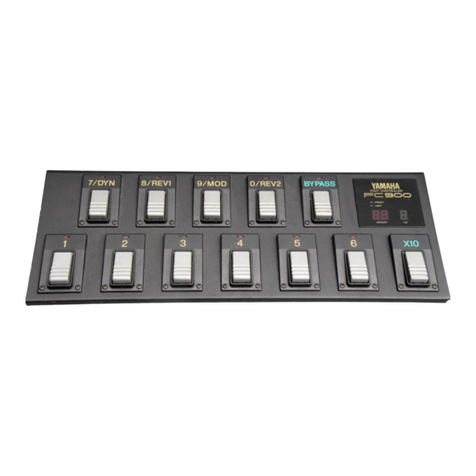
Yamaha
Yamaha FC900 operating manual
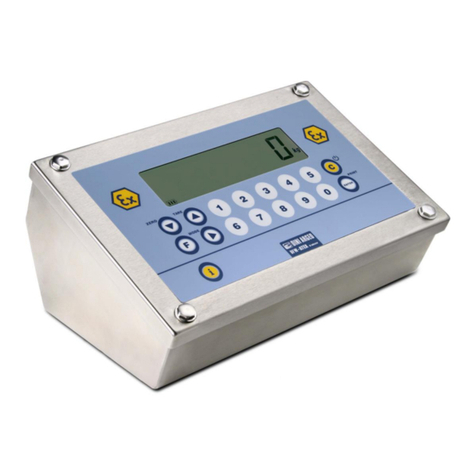
Dini Argeo
Dini Argeo DFWATEX2GD Technical manual
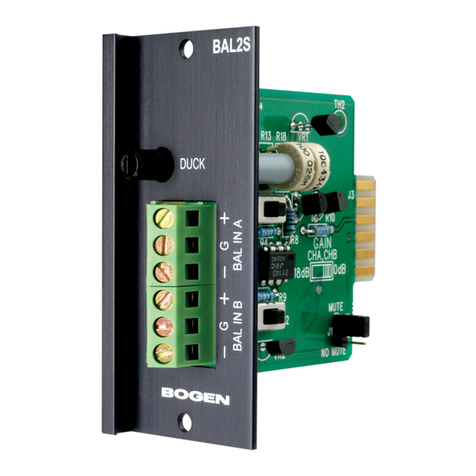
Bogen
Bogen BAL2S Specifications
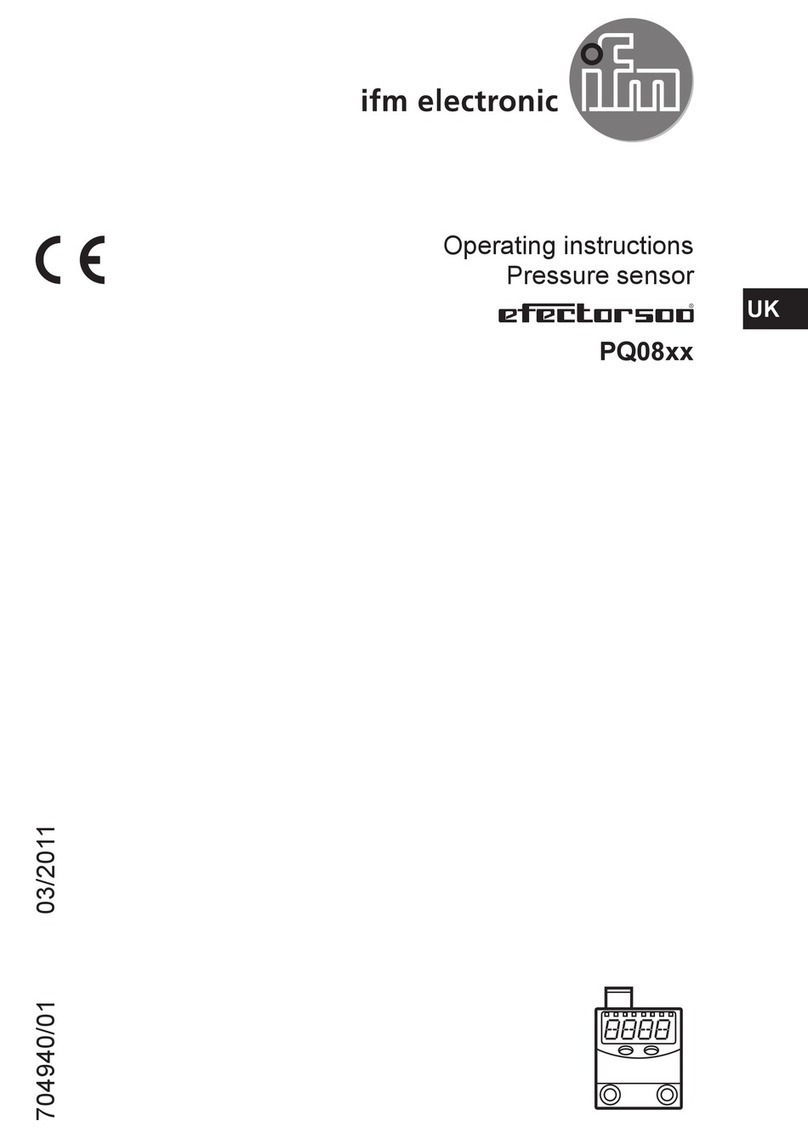
IFM Electronic
IFM Electronic efector500 PQ08 Series operating instructions

MELINERA
MELINERA HG01082A Assembly, operating and safety instructions
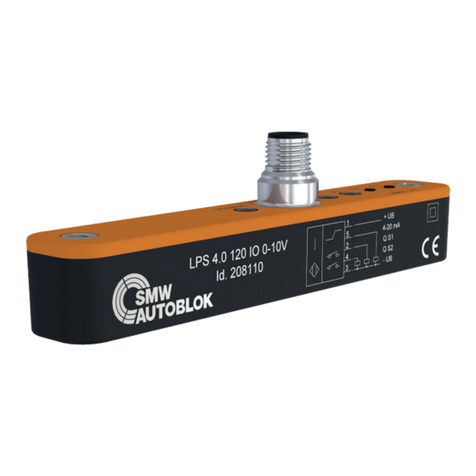
SMW Autoblok
SMW Autoblok LPS 4.0 120 IO instruction manual
